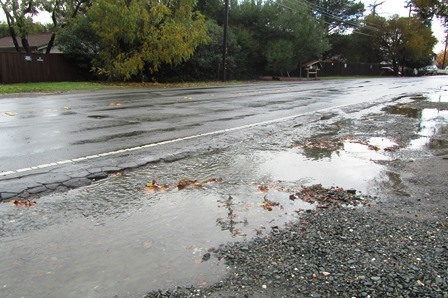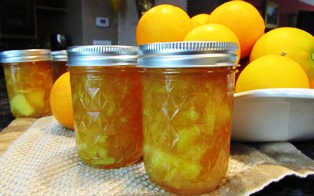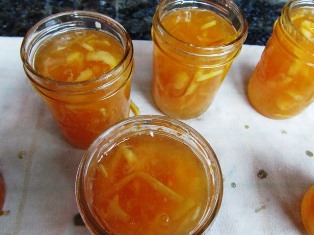Rain, Russian Poetry, Rugelach, and Longfellow
It’s been raining for hours. It’s the kind of day I love to listen to classical music, read Russian poetry, and dine on tea and apricot/walnut rugelach. The rugelach recipe is not mine, but I did use my Henny Penny Farmette apricot jam in the making of it. For the recipe, see, http://www.foodnetwork.com/recipes/ina-garten/rugelach-recipe.html
I could be doing a lot of other things like writing on my novel (but I’ve already put in four hours today on that, having arisen at 4:00 a.m., so a break is in order). I could be doing laundry, mopping the floors, decorating the house for the holidays, or changing the bedding. But I’m not.
I’ve missed the rain that brings the smell of decay and greens the moss.
California has been in a terrible drought for three long years. We’re going to get a week of wet stuff, say our weather forecasters. I want to enjoy these blessed, wet moments.
I let the chickens out of the hen house to forage, but they’ve remained in a huddle beneath it. A cold, unstable air mass will bring thunderstorms this afternoon. I doubt the chickens will even leave the run today, but that’s okay, too.
It’s a perfect day for me to stay inside. Maybe I’ll make bread. There’s enough time still for two risings. I’ll form it into a braid and bake it for dinner. Perhaps I’ll make a hearty soup–one from Brother Victor-Antoine d’Avila-Latourrette’s Twelve Months of Monastery Soup book. A citrus salad would be the perfect accompaniment.
What was it Henry Wadsworth Longfellow said about rain, “The best thing one can do when it’s raining is to let it rain.”
Easy Orange Marmalade
Who can resist the flavors of homemade jams? Whether it embellishes an appetizer of grilled fig and melted goat cheese or is spread upon a fat slice of fresh-baked bread, jam has power to elevate any meal to another level.
Using the seedless oranges growing on our farmette trees, I’m making marmalade. Marmalade made with the oranges ripening this time of year make great additions to holiday gift baskets. I like to add jars of honey, fresh tangerines, nuts, summer jams, and homemade treats.
RECIPE FOR ORANGE MARMALADE
Ingredients:
4 large oranges (preferably a seedless variety)
2 medium lemons
1/2 teaspoon butter (to reduce foaming)
1/8 teaspoon baking soda
6 Tablespoons dry classic pectin
5 1/2 cups sugar
Directions for Preparing the Jars and Canner:
Wash pint jars in the dishwasher or wash the jars and screw rings in hot soapy water, rinse, and drain upside down on paper towels.
Remove the wire rack from the canner and set aside; then, fill the canner half full of water and bring to a simmer.
Directions for Making the Fruit Mixture:
Wash the oranges and lemons.
Peel the fruit, using a vegetable peeler or a sharp paring knife. Discard any seeds and the pithiest parts of the inner peeling as the pith tastes bitter.
Cut the peeled skins into narrow strips.
Pour water into a saucepan.
Add baking soda and strips of peel.
Bring to boil and then reduce the heat, simmering for 20 minutes and stirring as needed.
Cut the fruit into thin quarters.
Add the fruit and juice to the saucepan of simmering peelings, cover, and allow everything to simmer for 10 minutes.
Remove 4 cups of the fruit/peeling/juice mixture and pour into a large saucepan (6 or 8 quart) or stock pot.
Stir in the pectin and add the butter and sugar, mixing well.
Bring to a roiling boil, stirring constantly, for a full minute and then remove from heat, skimming off any foam.
How to Can the Marmalade:
Ladle the fruit mixture into the warm, clean jars, leaving between 1/4 and 1/8 inch space from the top.
Wipe the jar rims before placing the jars on the wire rack of the canner.
Lower the wire rack of jars into the simmering water in the canner.
Make sure the jars are covered by 2 inches of water (add boiling water if necessary).
Cover with lid and boil for 15 to 20 minutes.
Turn off flame, remove the jars of marmalade, and set them onto a towel to cool.
Listen for the popping sound that signals the lids have sealed. Check lids for seal once the jars have cooled by pushing against the center of the lid. If it springs, the jar has not sealed and must be refrigerated. The marmalade will still be good to eat.
 Facebook
Facebook Goodreads
Goodreads LinkedIn
LinkedIn Meera Lester
Meera Lester Twitter
Twitter







